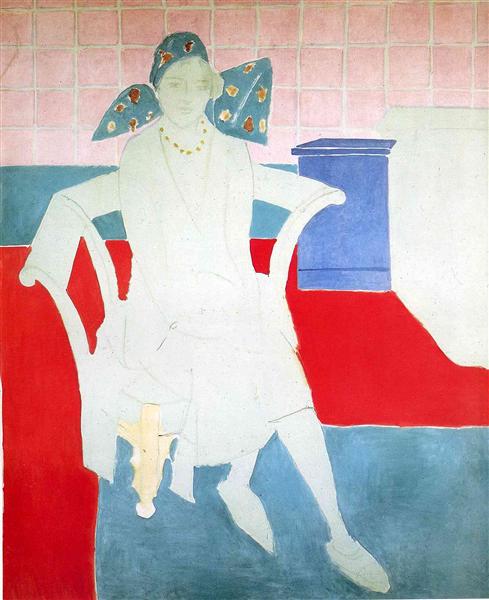Description
In the universe of Henri Matisse, one of the most relevant figures of modern art, we find the work "Woman with a Madras Hat" (1930). This painting, with its dimensions of 49x60 cm, encapsulates not only the essence of Matisse's technique but also the audacity and innovation with which he approached the female portrait. The portrayed figure, a calm and serene woman wearing a striking "madras" hat, offers us a window into the colorful and dynamic world of the French artist.
The composition of "Woman with a Madras Hat" is a clear example of Matisse's interest in patterns and color contrasts. The choice of a madras hat, a fabric paintings originating from India known for its vibrant colors, allows Matisse to explore a rich and varied chromatic palette. The orange, yellow, and green tones of the hat complement the background of the painting, also composed of vibrant geometric patterns in red, green, and blue tones. This juxtaposition creates a harmonious atmosphere despite the striking use of color, a distinctive characteristic of Fauvism, an artistic movement in which Matisse was a central figure.
Observing more closely, one notices the deliberate simplicity of lines and shapes. The woman's face and expression are reduced to minimal but precise strokes, managing to convey an introspective quietness. This tendency towards simplification may be influenced by African and Oriental art, which Matisse admired and often turned to for inspiration.
A fascinating aspect of this work is how Matisse manages to balance the female figure with the background elements without either dominating the composition. Color is the true protagonist here, as it is in many of his works. Matisse once claimed that "color must be thought, dreamed, imagined." In "Woman with a Madras Hat," this philosophy of color becomes evident and allows the painting to transcend mere portraiture and become a dance of tones.
It is also interesting to highlight the period in which this work was created, the late 1920s and early 1930s, a time when Matisse was in transition. It was not just a technical evolution but also a conceptual one. He had left behind the more furious Fauvist experiments of his beginnings and was moving towards a more controlled and linear style, even as he continued to value the vitality and dynamism of color.
"Woman with a Madras Hat" can also be interpreted within the context of the role that Matisse gave to women in his work. The women in his paintings often represent beauty, peace, and creativity. In this portrait, Matisse approaches the female figure with a respectful distance but also with an emotional closeness that captures the essence of the model's character.
In summary, "Woman with a Madras Hat" is a testament to Matisse's ability to innovate within portraiture and offer a rich visual experience through his masterful use of color and form. It is a celebration of simplicity and, at the same time, a meditation on the complexity of psychology and visual culture. This work remains a highlight in his career, reminding us why Henri Matisse is revered as a master of color and a cardinal figure in the history of modern art.

